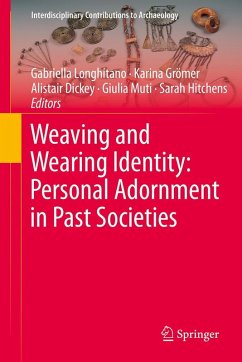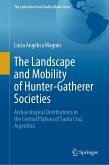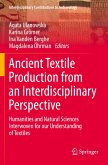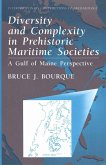Weaving and Wearing Identity: Personal Adornment in Past Societies
Herausgegeben:Longhitano, Gabriella; Grömer, Karina; Dickey, Alistair; Muti, Giulia; Hitchens, Sarah
Weaving and Wearing Identity: Personal Adornment in Past Societies
Herausgegeben:Longhitano, Gabriella; Grömer, Karina; Dickey, Alistair; Muti, Giulia; Hitchens, Sarah
- Gebundenes Buch
- Merkliste
- Auf die Merkliste
- Bewerten Bewerten
- Teilen
- Produkt teilen
- Produkterinnerung
- Produkterinnerung
This book examines questions surrounding body adornments and its link to identity in archaeology, looking at theoretical and interpretive frameworks that are relevant to the study of different categories of personal ornaments. Identity is a crucial topic in archaeology where its concept is investigated through the study of many categories of material culture. As self-representation, identity constitutes a choice through which an individual or a group want to be seen by others. The volume covers a wide geographical and chronological frame from the Upper Paleolithic era to Medieval times,…mehr
Andere Kunden interessierten sich auch für
![Multidisciplinary Approaches for the Investigation of Textiles and Fibres in the Archaeological Field Multidisciplinary Approaches for the Investigation of Textiles and Fibres in the Archaeological Field]() Multidisciplinary Approaches for the Investigation of Textiles and Fibres in the Archaeological Field100,99 €
Multidisciplinary Approaches for the Investigation of Textiles and Fibres in the Archaeological Field100,99 €![The Late Neolithic and Early Chalcolithic Imagery in South-Central Anatolia The Late Neolithic and Early Chalcolithic Imagery in South-Central Anatolia]() Patrycja FilipowiczThe Late Neolithic and Early Chalcolithic Imagery in South-Central Anatolia84,99 €
Patrycja FilipowiczThe Late Neolithic and Early Chalcolithic Imagery in South-Central Anatolia84,99 €![The Landscape and Mobility of Hunter-Gatherer Societies The Landscape and Mobility of Hunter-Gatherer Societies]() Lucía Angélica MagninThe Landscape and Mobility of Hunter-Gatherer Societies83,99 €
Lucía Angélica MagninThe Landscape and Mobility of Hunter-Gatherer Societies83,99 €![Ancient Textile Production from an Interdisciplinary Perspective Ancient Textile Production from an Interdisciplinary Perspective]() Ancient Textile Production from an Interdisciplinary Perspective123,99 €
Ancient Textile Production from an Interdisciplinary Perspective123,99 €![Ancient Textile Production from an Interdisciplinary Perspective Ancient Textile Production from an Interdisciplinary Perspective]() Ancient Textile Production from an Interdisciplinary Perspective123,99 €
Ancient Textile Production from an Interdisciplinary Perspective123,99 €![Diversity and Complexity in Prehistoric Maritime Societies Diversity and Complexity in Prehistoric Maritime Societies]() Bruce J. BourqueDiversity and Complexity in Prehistoric Maritime Societies38,99 €
Bruce J. BourqueDiversity and Complexity in Prehistoric Maritime Societies38,99 €![Diversity and Complexity in Prehistoric Maritime Societies Diversity and Complexity in Prehistoric Maritime Societies]() Bruce J. BourqueDiversity and Complexity in Prehistoric Maritime Societies93,99 €
Bruce J. BourqueDiversity and Complexity in Prehistoric Maritime Societies93,99 €-
-
-
This book examines questions surrounding body adornments and its link to identity in archaeology, looking at theoretical and interpretive frameworks that are relevant to the study of different categories of personal ornaments. Identity is a crucial topic in archaeology where its concept is investigated through the study of many categories of material culture. As self-representation, identity constitutes a choice through which an individual or a group want to be seen by others. The volume covers a wide geographical and chronological frame from the Upper Paleolithic era to Medieval times, examining North, Central, and Southern Europe as well as regions in Southwest Asia and North Africa.
This book is based on a session organised at the European Archaeological Association (EAA) in 2023, with a commonality, namely, body adornments. Participants explored the ways in which possessing, wearing and/or trading personal ornaments was a means through which individual and social identity could be expressed in antiquity. This volume is of relevance to archaeological researchers, practitioners, and students.
This book is based on a session organised at the European Archaeological Association (EAA) in 2023, with a commonality, namely, body adornments. Participants explored the ways in which possessing, wearing and/or trading personal ornaments was a means through which individual and social identity could be expressed in antiquity. This volume is of relevance to archaeological researchers, practitioners, and students.
Produktdetails
- Produktdetails
- Interdisciplinary Contributions to Archaeology
- Verlag: Springer / Springer Nature Switzerland / Springer, Berlin
- Artikelnr. des Verlages: 89292418, 978-3-032-03905-7
- Seitenzahl: 298
- Erscheinungstermin: 1. Februar 2026
- Englisch
- Abmessung: 235mm x 155mm
- ISBN-13: 9783032039057
- ISBN-10: 3032039053
- Artikelnr.: 74974105
- Herstellerkennzeichnung
- Springer-Verlag GmbH
- Tiergartenstr. 17
- 69121 Heidelberg
- ProductSafety@springernature.com
- Interdisciplinary Contributions to Archaeology
- Verlag: Springer / Springer Nature Switzerland / Springer, Berlin
- Artikelnr. des Verlages: 89292418, 978-3-032-03905-7
- Seitenzahl: 298
- Erscheinungstermin: 1. Februar 2026
- Englisch
- Abmessung: 235mm x 155mm
- ISBN-13: 9783032039057
- ISBN-10: 3032039053
- Artikelnr.: 74974105
- Herstellerkennzeichnung
- Springer-Verlag GmbH
- Tiergartenstr. 17
- 69121 Heidelberg
- ProductSafety@springernature.com
Gabriella Longhitano is a postdoctoral researcher at the Department of Cultural Heritage at the University of Salento (Italy). She is an archaeologist specialised in ancient textile production and related social practices, as well as microscopic analysis of textiles and fibres. She received a PhD in Archaeology in 2019 from the University of Liverpool and a second PhD in Cultural Heritage from the University of Catania in 2023. She has excavated in Crete and several sites in Southern Italy. She is also the author of a monograph and other papers on textile tools and textiles from ancient Sicily. Karina Grömer is the director of the Department of Prehistory, Natural History Museum Vienna. She studied Prehistoric Archaeology, Ethnology and Anthropology at the University of Vienna in Austria. Habilitation thesis (2019): “Archaeological Textile Research - Technical, economic and social aspects of textile production and clothing from Neolithic to the Early Modern Era”. She is specialised on interdisciplinary and integrated analysis of textiles, research on textile tools and reconstruction of prehistoric costume. Her research covers a timespan from c. 2500 BC till 1000 AD and a geographical area from Central Europe to Iran (research projects e.g. “DressID - Clothing and Identity in Roman Empire”, “CinBA – Creativity in the Bronze Age” and “Chehrabad Saltmummy & Saltmine Exploration Project”). She is also teaching at the Universities Vienna (Austria) and Ljubljana (Slovenia). Alistair Dickey is an archaeologist, holding a PhD (2022) in Egyptology from the University of Liverpool specialising in pre-historic archaeological textiles from the Nile Valley. By applying cutting-edge materials science methodologies to the study of archaeological textiles in both field and lab contexts, he is particularly interested in issues of materiality, exploring fibre choices, tracing thread technological development, examining societal cloth use, and re-assessing the ancient textile chaîne opératoire. Alistair is currently involved in textile research collaborations with the Fashioning Sudan project, the Metropolitan Museum of Art, and the Hierakonpolis Expedition, examining Neolithic to Bronze Age textiles from the Nile Valley. He has excavated extensively in several countries, including Egypt, Cyprus, Northern Ireland, Italy, Kazakhstan, Lebanon, and the Kingdom of Saudi Arabia. Alistair currently works in heritage archaeology as Consultant and Field Director with ArcheoConsultant, documenting historic al-Balad in Jeddah, KSA. Giulia Muti is a textile archaeologist specialising in prehistoric Cyprus. Her research interests also include island archaeology, gender studies and New Materialisms. Giulia received her PhD in Archaeology from the University of Manchester in 2020. In 2022, she was awarded the ‘E.J. Peltenburg Postdoctoral Fellowship in Cypriot Prehistory’ (CAARI, Nicosia). Giulia is currently a Research Assistant at the McDonald Institute for Archaeological Research (University of Cambridge), where she is responsible for reorganising and cataloguing legacy archaeological archives. She has authored several publications, including a study on Aegean-style discoid loom weights in Late Bronze Age Cyprus, which earned her the Levant Summer 2024 Prize for Best Article by an Early Career Scholar. Sarah Hitchens is an archaeologist who specialises in both textiles and textile processing implements. Although her work primarily focuses on Nubian and Egyptian material, she has also worked on 19th century coffin textiles from Liverpool. Sarah mostly works with material dating from the Meroitic to the Ottoman periods. However, her most recent research focuses on textile impressions from the back of clay sealings from the Old Kingdom. She is particularly interested in fibre identification, spinning technology, changes in textile production in an area over an extended time period, and the life-cycle of textiles through their use, re-use, recycling, and eventual discard. She has excavated in Egypt, Mexico, Sudan, Saudi Arabia and the UK. She holds a PhD in Egyptology (2023) from the University of Liverpool. She is currently a postdoctoral researcher at the Department of Archaeology at the University of York.
Chapter 1. Introduction The archaeology of adorning human bodies: Making, wearing and negotiating identity (Giulia Muti, Gabriella Longhitano, Sarah Hitchens, Alistair Dickey and Karina Grömer).- Part I: North and Central Europe.- Chapter 2. Wearing narratives of identity at the mid Upper Palaeolithic site of Grub-Kranawetberg (Austria) (Marjolein D. Bosch, Walpurga Antl Weiser, Aldona Kurzawska, Mathias Harzhauser, and Philip R. Nigst).- Chapter 3. Recreating Bronze Age clothing design in Central Europe as evidenced by textile and pictorial sources (Kayleigh Saunderson and Karina Grömer).- Chapter 4. Male dress in the Roman Province Noricum, fourth and fifth century AD (Karina Grömer).- Chapter 5. All that glitters ain t gold Jewellery items and dress ornaments as identity markers in Avar-period funerary contexts (seventh-eighth century AD) from Eastern Austria: Theoretical and methodological considerations (Birgit Bühler).- Chapter 6. Textiles, feathers and dress identity in the Lombard period burial ground of Maria Ponsee, Austria (Anna Zimmermann and Karina Grömer).- Chapter 7. Faking purple, seeing red: Reconstruction of recipes and baselines for madder dyeing (Katrin Kania and Micky Schoelzke).- Part II: Mediterranean area.- Chapter 8. Wearing violence: Pre-Roman Central Italian weapons between practice and display (eighth to fifth century BC) (Elena Scarsella).- Chapter 9. Elements of identity to be worn: Reconstructing clothing culture in the Iron Age communities of Sicily through dress ornaments (Gabriella Longhitano).- Chapter 10. Jewellery fashion in the Greek colonies (Angeliki Liveri).- Chapter 11. Spinning on female identity in the Iberian culture (Patricia Rosell Garrido).- Part III: South West Asia and Africa.- Chapter 12. Bodies and behaviours: Archaeological material culture and the interpretation of identity at the Neolithic transition (Emma Baysal and Sera Yelozer).- Chapter 13. Dressed to connect: Ornamental strategies of affiliation in the third millennium BC, Cyprus (Rafael Laoutari).- Chapter 14. You are what you wear from your feet to your hair : Weaving narratives of identity at an Early Byzantine necropolis in Egypt (Kristin South).- Chapter 15. Concluding remarks (Anastasia Christophilopoulou).- Index.
Chapter 1. Introduction The archaeology of adorning human bodies: Making, wearing and negotiating identity (Giulia Muti, Gabriella Longhitano, Sarah Hitchens, Alistair Dickey and Karina Grömer).- Part I: North and Central Europe.- Chapter 2. Wearing narratives of identity at the mid Upper Palaeolithic site of Grub-Kranawetberg (Austria) (Marjolein D. Bosch, Walpurga Antl Weiser, Aldona Kurzawska, Mathias Harzhauser, and Philip R. Nigst).- Chapter 3. Recreating Bronze Age clothing design in Central Europe as evidenced by textile and pictorial sources (Kayleigh Saunderson and Karina Grömer).- Chapter 4. Male dress in the Roman Province Noricum, fourth and fifth century AD (Karina Grömer).- Chapter 5. All that glitters ain t gold Jewellery items and dress ornaments as identity markers in Avar-period funerary contexts (seventh-eighth century AD) from Eastern Austria: Theoretical and methodological considerations (Birgit Bühler).- Chapter 6. Textiles, feathers and dress identity in the Lombard period burial ground of Maria Ponsee, Austria (Anna Zimmermann and Karina Grömer).- Chapter 7. Faking purple, seeing red: Reconstruction of recipes and baselines for madder dyeing (Katrin Kania and Micky Schoelzke).- Part II: Mediterranean area.- Chapter 8. Wearing violence: Pre-Roman Central Italian weapons between practice and display (eighth to fifth century BC) (Elena Scarsella).- Chapter 9. Elements of identity to be worn: Reconstructing clothing culture in the Iron Age communities of Sicily through dress ornaments (Gabriella Longhitano).- Chapter 10. Jewellery fashion in the Greek colonies (Angeliki Liveri).- Chapter 11. Spinning on female identity in the Iberian culture (Patricia Rosell Garrido).- Part III: South West Asia and Africa.- Chapter 12. Bodies and behaviours: Archaeological material culture and the interpretation of identity at the Neolithic transition (Emma Baysal and Sera Yelozer).- Chapter 13. Dressed to connect: Ornamental strategies of affiliation in the third millennium BC, Cyprus (Rafael Laoutari).- Chapter 14. You are what you wear from your feet to your hair : Weaving narratives of identity at an Early Byzantine necropolis in Egypt (Kristin South).- Chapter 15. Concluding remarks (Anastasia Christophilopoulou).- Index.








